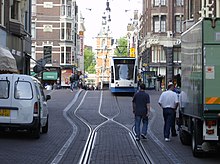
Back مدينة الخمس عشرة دقيقة Arabic Dinas 15 Munud Welsh Ciudad de 15 minutos Spanish 15 minutuko hiri Basque Ville du quart d'heure French עיר 15 דקות HE 15-minutni grad Croatian Kota 15 menit ID Città di 15 minuti Italian 15-minutenstad Dutch

The 15-minute city (FMC[2] or 15mC[3]) is an urban planning concept in which most daily necessities and services, such as work, shopping, education, healthcare, and leisure can be easily reached by a 15-minute walk, bike ride, or public transit ride from any point in the city.[4] This approach aims to reduce car dependency, promote healthy and sustainable living, and improve wellbeing and quality of life for city dwellers.[5]
Implementing the 15-minute city concept requires a multi-disciplinary approach, involving transportation planning, urban design, and policymaking, to create well-designed public spaces, pedestrian-friendly streets, and mixed-use development. This change in lifestyle may include remote working which reduces daily commuting and is supported by the recent widespread availability of information and communications technology. The concept has been described as a "return to a local way of life".[6]
The concept's roots can be traced to pre-modern urban planning traditions where walkability and community living were the primary focus before the advent of street networks and automobiles. In recent times, it builds upon similar pedestrian-centered principles found in New Urbanism, transit-oriented development, and other proposals that promote walkability, mixed-use developments, and compact, livable communities.[7] Numerous models have been proposed about how the concept can be implemented, such as 15-minute cities being built from a series of smaller 5-minute neighborhoods, also known as complete communities or walkable neighborhoods.[4]
The concept gained significant traction in recent years after Paris mayor Anne Hidalgo included a plan to implement the 15-minute city concept during her 2020 re-election campaign.[1] Since then, a number of cities worldwide have adopted the same goal and many researchers have used the 15-minute model as a spatial analysis tool to evaluate accessibility levels within the urban fabric.[2][4][8]
In early 2023, far-right conspiracy theories emerged that described 15-minute cities as instruments of government repression.[9][10][11][12]
- ^ a b Willsher, Kim (7 February 2020). "Paris mayor unveils '15-minute city' plan in re-election campaign". The Guardian. Retrieved 12 March 2021.
- ^ a b Cite error: The named reference
Pozoukidou 2021was invoked but never defined (see the help page). - ^ "The 15-minute City Transition Pathway (15mC)". Vienna: Driving Urban Transitions Partnership, JPI Urban Europe. n.d. Retrieved 13 March 2023.
- ^ a b c Cite error: The named reference
Weng 2019was invoked but never defined (see the help page). - ^ Cite error: The named reference
Patterson, Lancewas invoked but never defined (see the help page). - ^ Cite error: The named reference
O'Sullivan 2020was invoked but never defined (see the help page). - ^ Pozoukidou, Georgia; Angelidou, Margarita (2022). "Urban Planning in the 15-Minute City: Revisited under Sustainable and Smart City Developments until 2030". Smart Cities. 5 (4): 1356–1375. doi:10.3390/smartcities5040069. ISSN 2624-6511.
- ^ Cite error: The named reference
Boukouras 2022was invoked but never defined (see the help page). - ^ Cite error: The named reference
Hsu 2023was invoked but never defined (see the help page). - ^ Cite error: The named reference
Paddison 2023was invoked but never defined (see the help page). - ^ Cite error: The named reference
McCarthy 2023was invoked but never defined (see the help page). - ^ Cite error: The named reference
Sethi 2023was invoked but never defined (see the help page).
© MMXXIII Rich X Search. We shall prevail. All rights reserved. Rich X Search
